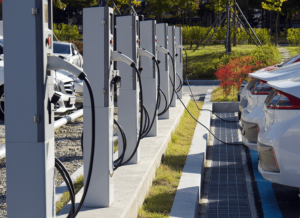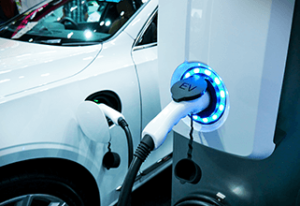Opportunities and challenges in EV chargepoint infrastructure
By James Hilsdon and Michael Hay of Valemus Law
The road to zero
 If Ridley Scott’s Blade Runner was an accurate vision of the future the roads of 2019 would look very different. Alas, it was not to be and instead of a window into the future it just turned out to be a great film. Brambilla’s Demolition Man (1993), with its electric cars and self-driving tech set in 2032, might end up being a pretty decent guess, on the transport front at least. Whilst Scott, and many other authors and filmmakers, might not have predicted the state of our transport infrastructure one thing is true: the 2020s are going to be a revolution for personal transport.
If Ridley Scott’s Blade Runner was an accurate vision of the future the roads of 2019 would look very different. Alas, it was not to be and instead of a window into the future it just turned out to be a great film. Brambilla’s Demolition Man (1993), with its electric cars and self-driving tech set in 2032, might end up being a pretty decent guess, on the transport front at least. Whilst Scott, and many other authors and filmmakers, might not have predicted the state of our transport infrastructure one thing is true: the 2020s are going to be a revolution for personal transport.
In their 2019 report on the opportunities for electric vehicle charge points, Deloitte estimated that the UK would need around 28,000 public charge points and to invest a further £1.6 billion in the infrastructure by 2030. This was before the UK government (HMG) announced it was bringing forward the ban on sales of new internal combustion engine (ICE) and hybrids from 2040 to 2035. A report commissioned by Scottish Power suggested the UK would need 2.6m public charging points by 2050 to meet its net zero target[1].
Then, in November 2020, HMG announced its ‘road to zero’: sales of new ICE cars and vans must cease by 2030. Hybrids can continue to be sold until 2035.
The cars of the near-future may not be flying, but they will certainly be different from the mainstream of 1950-2020.
With the current pace of change it is hard to look even 10 years ahead, so we do have some sympathy for the film-makers of the 1980s. Journey around the UK today and it is hard to imagine life in nine years’ time. The proportion of new electric car sales is increasing rapidly, but from a frankly insignificant base. In April it was reported that electric cars accounted for just 7.2% of total registrations so far in 2021.[2] Meanwhile, the infrastructure built around ICE vehicles remains intact, and the EV infrastructure, predominantly slower AC charge points, is barely noticeable in many places. If widespread EV car ownership is to become practical in the UK, and if consumers are to overcome their ‘range anxiety’, that will need to change, and change rapidly.
Challenges and opportunities
EV charging infrastructure as 3 key audiences at a fundamental level: “home”, which could be installed at an EV owner’s property or as nearby street furniture, “destination”, where an EV owner parks up and charges whilst undertaking some other task – often either a work or shopping destination, and lastly en route charging, where an EV owner pulls in for a quick charge before continuing their journey. Whilst home and destination options can be slow, en route needs to be as quick as possible.
HMG has made a number of announcements of support for the chargepoint infrastructure. Planning law has been relaxed; permission, usually a major factor and delay in green agenda projects, is not required where certain conditions are met. Regulation looks benign, with Ofgem taking a sensible view on the issue of whether a licence for supply will be required at charging stations. Money has been announced that targets specific areas as diverse as subsidising work-place chargepoint installation to funding for vital grid reinforcement works to support chargepoint infrastructure on the Strategic Road Network (SRN). Here is not the place to catalogue the various forms of financial support for EV or predict how that will evolve; it would likely be obsolete shortly after writing, and experience teaches us that HMG’s financial support schemes for environmental targets can be short-lived and subject to near-constant change, presenting a material risk to developers and their funders. Yet we can expect that there will be something on offer in some form as we go forward; the key thing is to be adept at spotting the opportunity and navigating the specific requirements of a given scheme.
 We have already seen signs that any such support is likely to come with evolving requirements that installations will need to meet, and with strings attached. Recent government consultations regarding EV charging infrastructure have suggested that HMG may intervene in a number of ways, for example, it may dictate payment method, it may prevent membership schemes, or, perhaps most significantly, it may insist on pricing transparency. Developers and their funders will need to consider the access requirements for any available support – whether it concerns the sourcing of equipment, for instance, or, the obligation to provide data. It will be vital to understand these requirements, and their implications, and to have the necessary assistance for putting together a successful bid.
We have already seen signs that any such support is likely to come with evolving requirements that installations will need to meet, and with strings attached. Recent government consultations regarding EV charging infrastructure have suggested that HMG may intervene in a number of ways, for example, it may dictate payment method, it may prevent membership schemes, or, perhaps most significantly, it may insist on pricing transparency. Developers and their funders will need to consider the access requirements for any available support – whether it concerns the sourcing of equipment, for instance, or, the obligation to provide data. It will be vital to understand these requirements, and their implications, and to have the necessary assistance for putting together a successful bid.
Some aspects of the chargepoint infrastructure currently attract no financial support, especially en route charging solutions, but could, nevertheless, represent a lucrative opportunity for landowners, developers and funders. As matters stand, home charging will remain a lengthy process due to the inability of an existing single-phase domestic electricity supply to support rapid or superfast charging. As the range of cars increases, the limitation of home charging becomes more apparent; latest models might take 20-24 hours to charge fully at home. Whilst some employers and councils are looking to provide chargepoints at workplaces or on highstreets these ‘destination’ charging solutions tend to also be low power with long charge times. If “range anxiety” is going to be overcome then EV buyers will need to be confident they can conveniently (and with certainty) make any trip they could otherwise have done in an ICE vehicle. So where do these customers charge? The answer to that has to be en route charging stations – the petrol stations of the future. These will need to have adequate coverage, and there are many opportunities to fill the gaps via car parks and other roadside sites where as few as, say, 8-10 chargepoints could prove profitable. Any development represents an opportunity for an O&M contract.
One challenge may be pricing. Projects may stack up now, based on the differential between the price the electricity is bought and current average charging point prices, but may face challenges in the longer term as price transparency and competition put margins under pressure. Market pressures may push installations to maximise their income opportunities with strategies such as buying power cheaply at off-peak hours, storing it locally, then then selling it at a higher price (arbitrage), providing grid balancing ancillary services or potentially claiming green house gas credits (via a licenced supplier, if these scheme is retained following a pilot), all of which require on-site energy storage. So called “vehicle to grid” may provide opportunities to home and destination charging stations, but are less likely to appeal to developers of en route charging stations.
The right navigator
EV charging infrastructure is likely to boom over the next 5-10 years. Put simply, if our transition away from the internal combustion engine is going to work it must. Current policy appears to be that the private sector provides this infrastructure, so the opportunities for developers in this space should be clear.
That being said, such development projects are often complex, and in exist in a fast-moving regulatory and technological environment where timescales are vital. Navigating this at speed requires multi-disciplinary support in the legal and regulatory space, encompassing not just conventional specialisations, such as finance, contracts and property law, but knowledge and experience of the complex regulatory framework that govern projects and any support that may be available, and a support partner that understands the industry and technology being deployed, and the partnerships such projects require, not least with the local DNO who will need to provide a grid connection.
We recognise that whether you are a developer, installer, operator, landowner or funder, you will need deft and flexible expert support from someone that understands exactly what you are trying to achieve and can provide you with the solutions to get there. Our focused team of legal professionals combine a wide base of legal expertise with a market and technical knowhow, building on our experience with projects during the renewable energy boom of the last decade, to give your project the best possibility of success.
If the opportunities of the coming EV boom are something you are considering, feel free to be in touch to see how we can help you get ahead.
[1] https://www.investorschronicle.co.uk/company-news/2020/02/12/is-the-uk-ready-for-electric-cars/
[2] https://www.drivingelectric.com/news/678/electric-car-sales-uk-market-down-but-continued-growth-for-evs-and-phevs


Leave A Comment